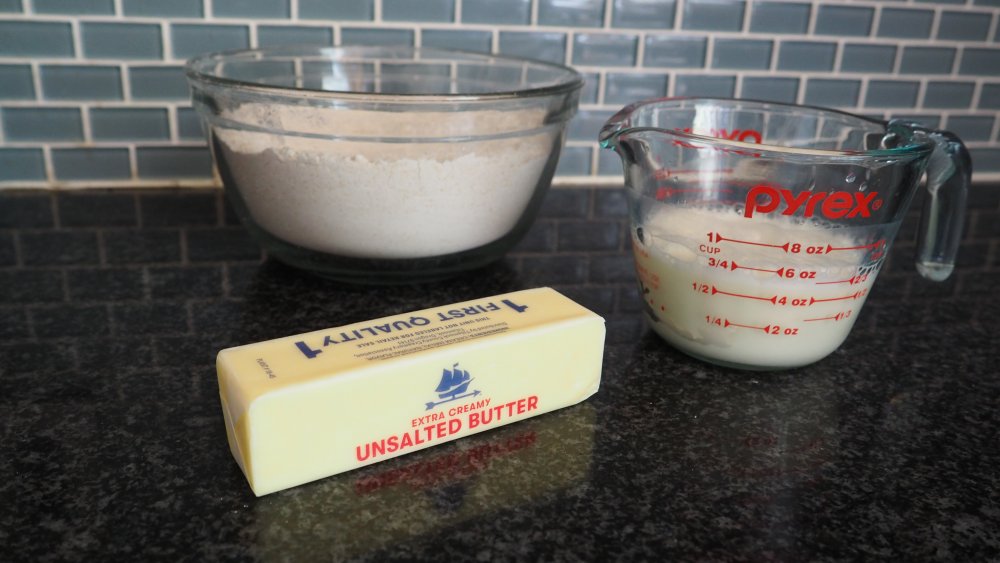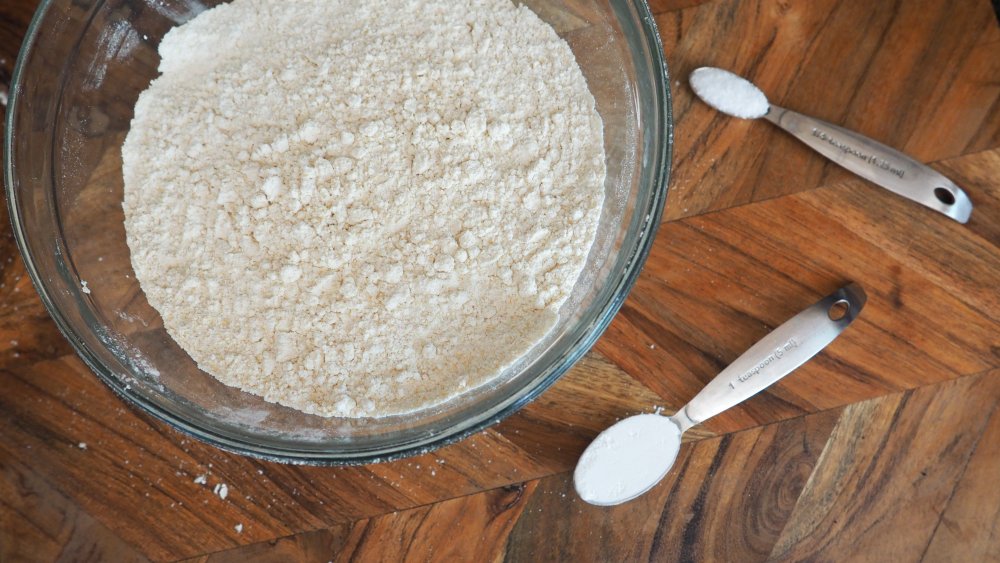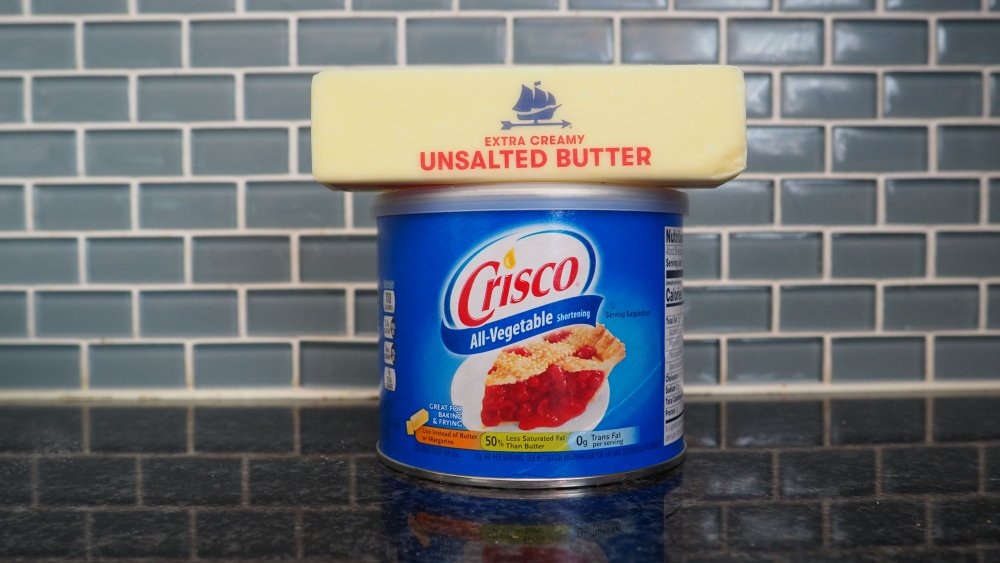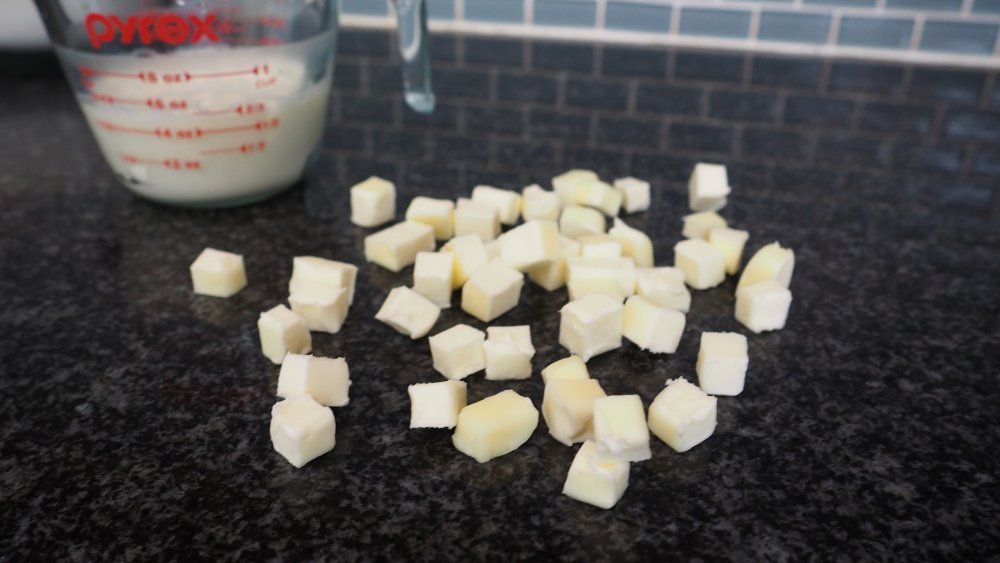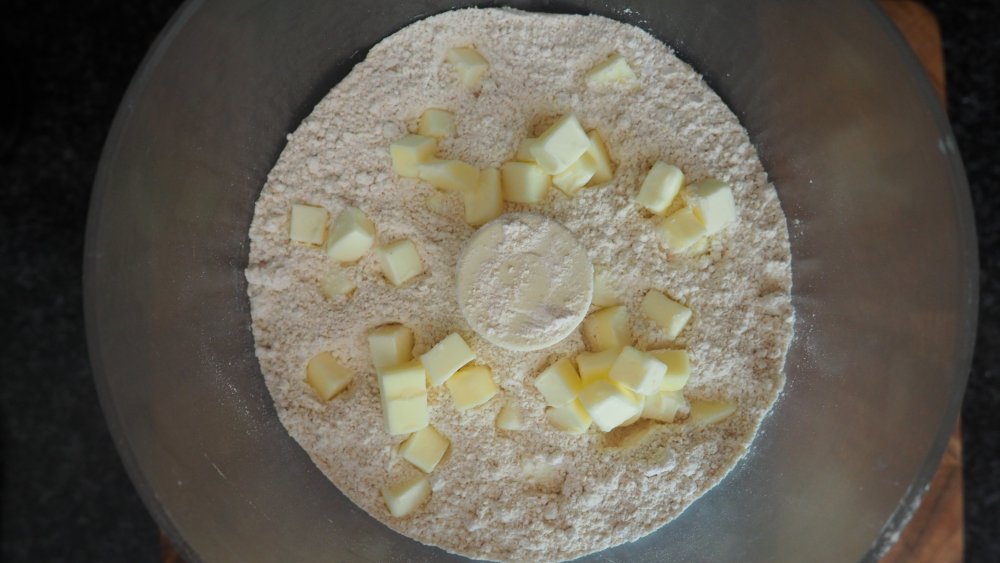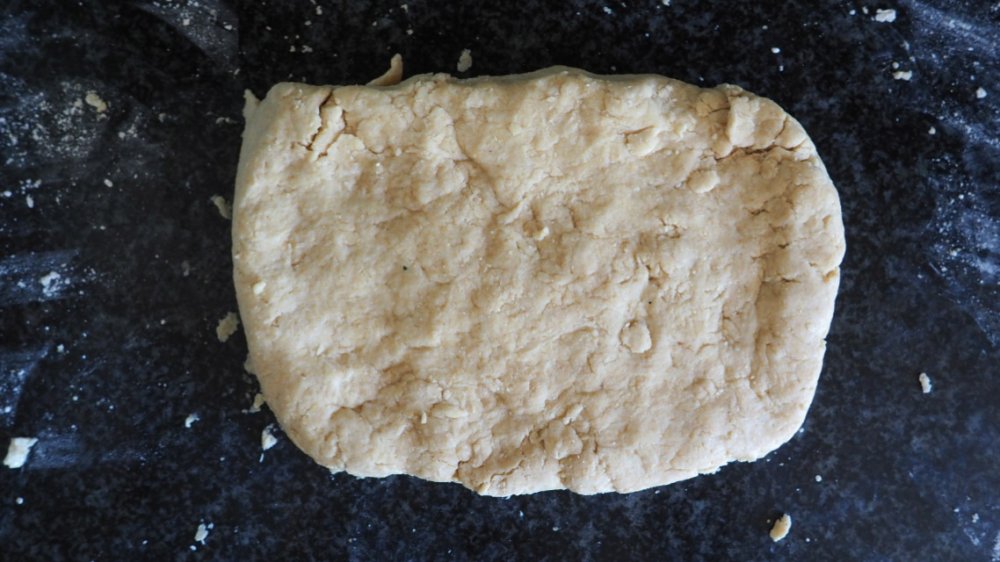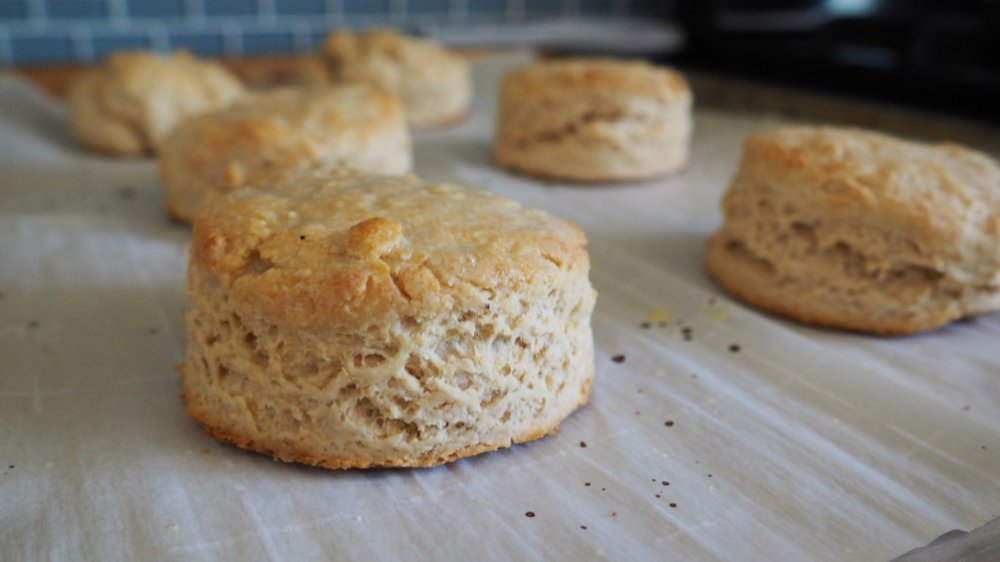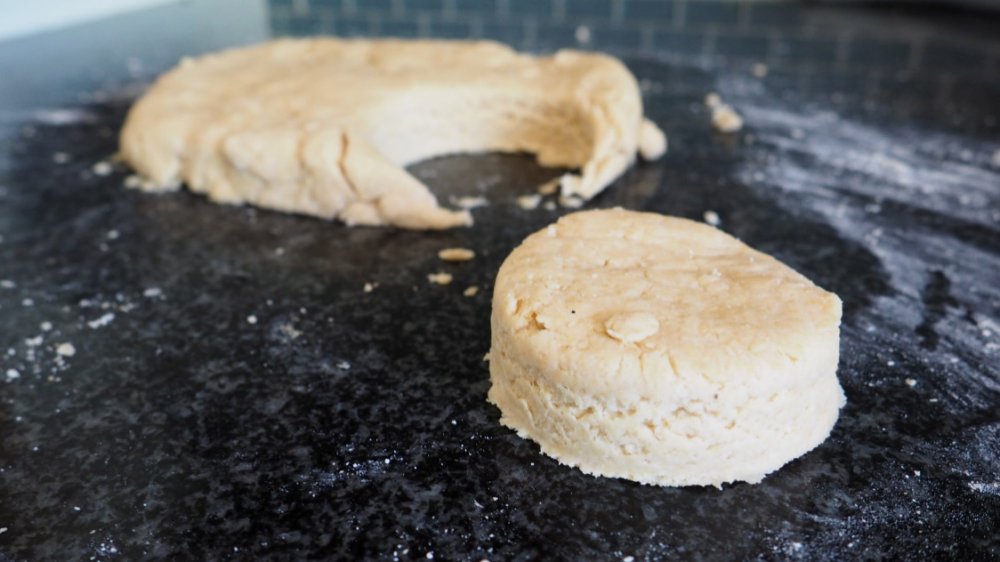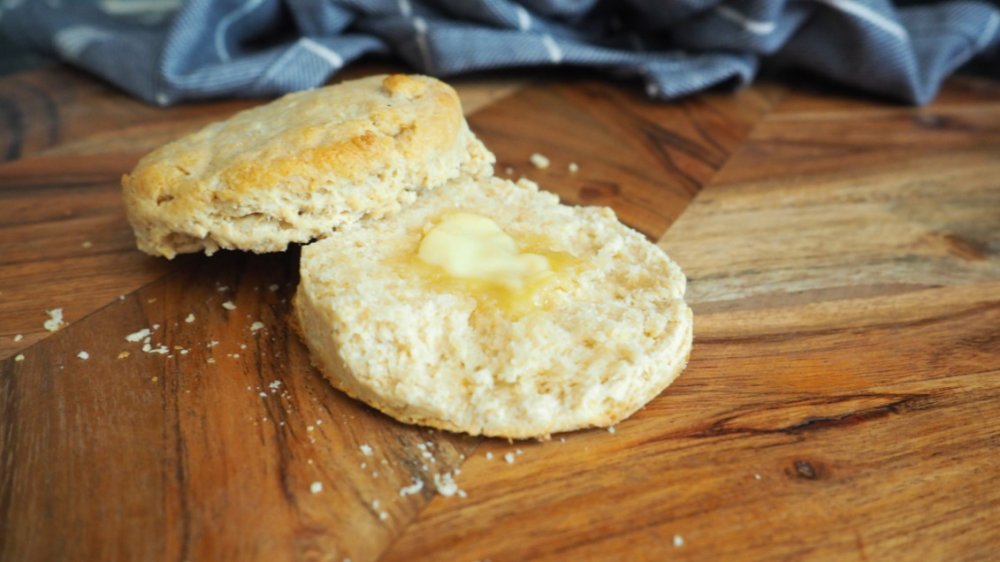3-Ingredient Biscuit Recipe
Most of us think of biscuits as a breakfast food, but they don't have to be reserved for the first meal of the day. If you're looking for a way to bake homemade bread to go alongside lunch or dinner and you don't want to fuss with kneading and rise time, 3-ingredient biscuits are the way to go. Their delightfully soft and chewy texture pairs well with everything from stew and chili to pulled pork and braised chicken. As a bonus, they only take a few minutes to pull together, so you can decide to whip up a batch 20 minutes before you're ready to eat. All you need is three ingredients and a little attention to detail.
If you've ever made biscuits that were a little too crumbly and dense, you might have accidentally committed an all-too-common baking mistake. A tender, flakey biscuit starts with choosing the right flour, keeping the ingredients at the right temperature, and mixing them just enough — but not too much. We'll tell you how to pull off the perfect biscuit, all with ingredients you probably already have on hand.
Gather the ingredients for 3-ingredient biscuits
You won't have to look far to round up the ingredients for these 3-ingredient biscuits. All you need is self-rising flour, butter, and buttermilk. This recipe is one of the reasons we always keep a container of shelf-stable powdered buttermilk in the pantry, allowing us to make biscuits without having to run out to the store. If you haven't stocked up on this pantry staple yet, there are a few substitutes you can use when you run out of buttermilk.
The easiest substitute is to add one tablespoon of white vinegar or lemon juice to one cup of regular milk. Of course, you could also swap-in regular milk instead, but you won't want to use heavy cream for this recipe. Heavy cream and butter both contain a lot of fat, which can weigh down the biscuit. We've also made these biscuits with regular old water. They do lack a bit of flavor, and they don't rise as impressively in the oven like the ones that use acidic buttermilk, but they still taste great in a pinch.
For a full list of the ingredients and step-by-step baking instructions, head to the directions section of this article.
Is there a substitute for self-rising flour in these 3-ingredient biscuits?
If you don't have self-rising flour, you can absolutely use all-purpose flour for this 3-ingredient biscuits recipe. Self-rising flour is seasoned and contains a leavening agent, so King Arthur Flour suggests adding 1/4 teaspoon salt and 1-1/2 teaspoons baking powder to every cup of all-purpose flour to use it as a substitute. But, even though it's an easy swap, it's worth it to head to the store and pick up a bag of self-rising flour anyway.
The reason this recipe works so well is that self-rising flour is made from a different type of wheat than all-purpose flour. White Lily self-rising flour — the brand Chick-fil-A uses in their iconic biscuits — is made with 100 percent soft red winter wheat. According to Bob's Red Mill, this wheat has a lower protein content, containing only 8.5 percent protein. All-purpose flour, on the other hand, is made from a combination of hard and soft wheat and contains 10 to 12 percent protein. Higher protein levels are ideal for crusty, chewy breads, but less protein is better for biscuits because it creates a softer, more tender crumb.
Can you make 3-ingredient biscuits with shortening?
We always keep a stick of butter in the freezer, just in case we happen to run out when the biscuit craving hits. But if you find yourself without any butter, don't worry; you can still make these 3-ingredient biscuits if you have shortening on hand. Some people actually prefer to use shortening when making biscuits, so you may find that you like it better.
For starters, butter is more flavorful than shortening, so the biscuits won't be as rich and may taste slightly bland. That's not the worst thing in the world, especially if you're smothering the biscuits with gravy or loading them up with jam. The other difference you'll notice is the texture. Shortening "shortens" the strands of gluten created by the flour, so the biscuits will be significantly more crumbly and cake-like. Not necessarily a bad thing, but not great if you're trying to make a biscuit sandwich. Butter also contains milk solids that will brown up more effectively in the oven, so the shortening biscuits will turn out a little bit paler.
The key to the best 3-ingredient biscuit
Want to know a secret that will make your 3-ingredient biscuits better? Use very cold butter. You see, butter contains solids known as butterfat, but it also contains moisture. When the butter is cold, it doesn't have a chance to incorporate with the flour and it remains intact inside the dough. When biscuits hit the oven, the moisture in the butter evaporates and turns into steam, creating little air pockets inside the biscuits. If the butter was already warm, it would incorporate into the dough ahead of time and you wouldn't achieve that lovely flakey texture.
If you have enough time to plan in advance, put the butter in the freezer after cutting or grating it. Even five minutes in the freezer will help the butter stay as cold as possible during the mixing stage. Then, when you're finished mixing, form and cut the dough right away so the butter doesn't have a chance to warm up.
Mix the ingredients for these 3-ingredient biscuits
Okay, now that we know all about how to make a perfect 3-ingredient biscuit, let's get cooking! Mixing the dough for biscuits is super simple. All you have to remember is not to overmix the dough, which can make the biscuits tough instead of tender. And don't forget to preheat the oven to 450 degrees Fahrenheit. Having the oven hot and ready is just as important as using cold butter.
Start by incorporating the butter and flour together. We like using a food processor, putting the flour and butter pieces in the machine and pulsing 20 to 25 times, until the mixture resembles wet sand. If you don't have a food processor, you can mix the ingredients by hand. Then, make a well in the center of the flour mixture and add the buttermilk. Mix the ingredients with a large spoon until the flour is just moistened. When the dough is mixed well enough to come together as a large mass, turn it out onto a floured work surface.
Roll the dough and cut the biscuits for this 3-ingredient biscuits recipe
Now that the dough has come together, gently press it so it forms a large ball. Don't knead it or overmix the dough; you just want to make sure it is sticking together enough to form the 3-ingredient biscuits. You can use a rolling pin to roll it out into a large rectangle if you like, but we've found that our hands work best here, patting the top and sides until the rectangle is about one-inch thick.
Grab a 2-1/2-inch biscuit cutter and cut six biscuits out of the dough. If you don't have a biscuit cutter, you should be able to use a measuring cup or the rim of a large drinking cup. Be sure not to twist the biscuit cutter from side to side as you use it, which can overwork part of the dough and make it tough. Just press it straight up and down, dusting it with a little flour if it wants to stick. After you make about four biscuits, you'll need to reform the dough into a 1-inch thick mass to cut the remaining two biscuits.
It's time to bake our 3-ingredient biscuits
From here, you're ready to bake the 3-ingredient biscuits. Place the biscuits on a baking sheet greased with butter or cooking spray, or use a sheet of parchment paper to line the baking sheet. Be sure your oven is fully preheated to 450 degrees Fahrenheit before you pop the biscuits into the oven. You want the cold butter inside the dough to expand as rapidly as possible, and a hot oven is the best way to get there.
After about 10 minutes, the biscuits should have risen and grown in size, and they should be beautifully browned on top. You can check if they're done with a toothpick — it should come out clean when pierced in the center of the biscuit — or you can use an instant-read thermometer to make sure the biscuits have reached 190 degrees.
To give the biscuits a boost of flavor and a shiny appearance, brush the tops with melted butter when they come out of the oven. Serve the biscuits as-is, or with butter, honey, or jam. It's never a bad idea to take things to the next level by smothering them with sausage gravy for breakfast, either. If you end up with leftovers, let them cool completely before storing them in an airtight container
Can you make 3-ingredient biscuits in advance?
A great way to make sure you always have fresh biscuits on hand is to prepare them in advance. Leftover baked biscuits never taste as good as the ones fresh out of the oven, but you have two options when it comes to prepping the 3-ingredient biscuits so they're always fresh.
The first method is to cut the butter into the flour and store it in the refrigerator in a sealed bag. It doesn't save a ton of time, but it does remove one step from the process. When you're ready for biscuits, add the buttermilk, form and cut the dough, and bake away.
The second option gets you almost all the way to finished biscuits. Prepare the entire biscuit recipe up to the point where the cut biscuits go into the oven. Instead, put the baking sheet into the freezer and wait until the biscuits are frozen. Transfer the frozen biscuits to a freezer-safe container and keep them frozen for up to three months. When you're ready to eat, cook them straight from the freezer, lowering the oven temperature to 425 degrees Fahrenheit and adding an extra five to ten minutes on the cooking time.
How did our 3-ingredient biscuits taste?
This recipe is not only super easy, but it's also incredibly delicious. These 3-ingredient biscuits taste just as good as ones we've made with more complicated recipes. They're soft, tender, and flakey, but they're sturdy enough to hold an egg for a breakfast sandwich. Between the baking powder in the self-rising flour and the acidic buttermilk, these biscuits achieved the perfect amount of rise, resulting in perfectly round, tall biscuits. All in all, we had zero complaints, and they were so delicious that we didn't even have to worry about leftovers; all six biscuits were gobbled up before they had a chance to cool down.
It's worth noting that you don't have to fuss with making perfect circles, either. We made another batch of these biscuits and cut them into squares. While they're not quite as restaurant-worthy in presentation, they were easier to make than reforming the dough for the last two biscuits, and they still tasted fantastic. You could also form the dough into a large circle and cut them into large triangles — like a scone — if you don't want to invest in a biscuit cutter.
Directions for the best 3-ingredient biscuits
If you're looking for a way to bake homemade bread to go alongside dinner and you don't want to fuss with kneading and rise time, biscuits are the way to go.
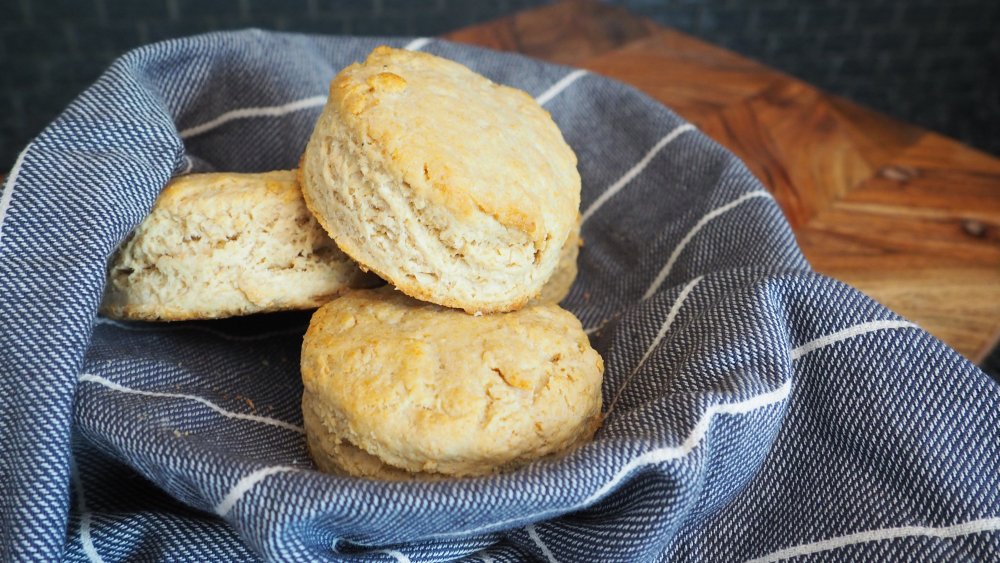
Ingredients
- 2 cups self-rising flour
- 1/4 cup cold butter, cut into small cubes (plus more for brushing, optional)
- 3/4 cup cold buttermilk
Directions
- Preheat the oven to 450 degrees Fahrenheit. Grease a baking sheet with butter or cooking oil, or line it with a sheet of parchment paper. Set aside.
- Place the flour and butter into the bowl of a food processor. Pulse the food processor 20 to 25 times, until the butter is incorporated and the mixture resembles wet sand. Alternatively, you can grate the butter using a box grater and mix it into the flour by hand.
- Transfer the flour mixture into a large bowl and make a well in the center. Pour the buttermilk into the center of the well and mix with a large spoon until the flour is just moistened. Do not overmix.
- Turn the dough out onto a lightly floured surface and gently bring it together into a large ball without kneading the dough. Using your hands, pat the dough until it's a 1-inch thick rectangle. If you prefer, you can use a rolling pin, but it may overwork the dough and cause it to become tough.
- Using a 2-1/2-inch biscuit cutter, cut 6 biscuits in a straight up-and-down motion (not a twisting motion), reforming the dough as needed to cut all the biscuits.
- Place the 3-ingredient biscuits onto the prepared baking sheet and bake for 10 minutes, until they're golden brown and cooked through. If you're testing the biscuits with an instant-read thermometer, they should register 190 degrees in the center.
- Brush the hot biscuits with melted butter (if using) and serve warm. Allow any leftover biscuits to cool completely before storing in an airtight container.
Nutrition
| Calories per Serving | 228 |
| Total Fat | 8.3 g |
| Saturated Fat | 5.1 g |
| Trans Fat | 0.3 g |
| Cholesterol | 21.6 mg |
| Total Carbohydrates | 32.4 g |
| Dietary Fiber | 1.1 g |
| Total Sugars | 1.6 g |
| Sodium | 556.3 mg |
| Protein | 5.2 g |
